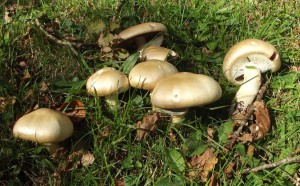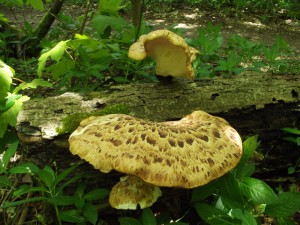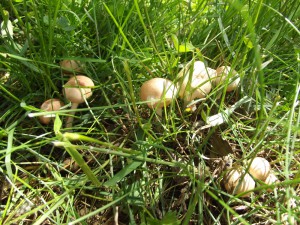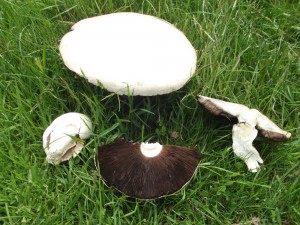Email: geoffdann@hotmail.com
Phone: 07964 569715
04/11/2013
There is currently a massive row going on in the UK about foraging for fungi, especially the activity of two overlapping groups of people: eastern european immigrants and gangs of commercial collectors. I was going to wait until after this year’s mushroom season was over before posting something about this, but events have prompted me to do it now.
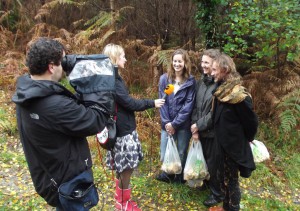
Filming for Russian Television REN-TV. Yes we were using the dreaded plastic bags – it was very wet and mushrooms in an open basket would have been soaked.
It has been a busy October for me. There have been plenty of mushrooms about, and I’ve had plenty of bookings. On top of all that I was contacted early in the month by Russian TV station REN-TV who wanted to spend the afternoon filming me at work teaching people about mushroom foraging and interviewing me both about what I do and the aforementioned furore. The piece was broadcast in Russia late last week and I posted it on my facebook page on Friday.
It immediately provoked a furious reaction from a Russian friend-of-friend who did not like the fact that I’d called commercial collectors from eastern Europe “robbers”. Not speaking Russian myself, I can’t know for sure what the translation of which bits of what I said was. So I am going to repeat what I said, in English, here.
My job is teaching people to forage responsibly and legally for fungi. As should be obvious, this is not very compatible with selling fungi to people: if it was my business to make money selling fungi then the last thing I’d want to do is teach other people how to identify commercially-collected species, and where to find them!
It is perfectly legal for people to pick fungi for their own personal usage in the UK, and my job is to enable people who don’t know anything about fungi to do this by supplying them with the information they need to tell the difference between what is good to eat, what isn’t, and what is poisonous. The nature of my job does not demand that I send my customers home with heaving baskets full of penny buns and chanterelles; I get paid the same amount whether we find one penny bun or twenty. And my customers learn far more if I find one specimen of twenty different species, especially the poisonous ones, than a massive load of something valuable.
It is not legal for people to pick fungi with a prior intent to sell in the UK, unless they have the landowner’s permission, for this becomes theft. The nature of that activity demands that people find as much of a handful of valuable species as they can. As soon as the profit-per-mushroom thing enters the equation, it is all too predictable what happens. Why, when every mushroom you pick brings you more money, would you leave any in place? The result is that commercial collectors are not only committing the crime of theft, but that they are stripping certain of locations of every mushroom they think they can sell. In some cases it is even worse than this, because there is a gang of people, most of who don’t even know which fungi are edible and which are not, and they are told to take everything that looks like it might be edible, including, inevitably, rare species that can’t be eaten. It is precisely this sort of behaviour which has led to a blanket ban on all picking of fungi in Epping Forest, with £200 fines for anybody caught breaking the rules. The problems described above are much worse closer to London. I have pretty much given up taking people foraging anywhere near the M25, let alone inside it. Although I have seen direct evidence of these activities this year as far from London as Hemsted Forest, halfway between Ashford and Tunbridge Wells.
On top of the commercial pickers, there is another change in the foraging landscape of the UK and that is being caused a cultural difference between British behaviour and that of people of certain eastern European countries, notably Poland. I’m sorry to have to name one particular nationality, especially since the nation in question was such a strong ally of the UK during the darkest years of the 20th century. Plus I like nearly all the Polish people I’ve met in the UK. Unfortunately their attitude to foraging is disrespectful to nature and is causing problems in various areas. Polish people have been banned from fishing in certain lakes because they’ve been stripping them of fish for their tables instead of releasing them back into the water. They’ve been caught killing wild waterfowl. And when it comes to fungi their attitude appears indistinguishable from that of the commercial collectors: take everything – the more bags you fill with boletes and chanterelles, the better. Again, I’ve seen direct evidence for this myself. I’ve seen/heard the people speaking Polish with bags stuffed to bursting (literally) with fungi, and then I’ve seen the woodland denuded of everything even remotely edible, including the mankiest of boletes I wouldn’t personally even consider eating. I know of two places where signs have been put up telling people not to pick fungi, written in Polish first and English underneath. 🙁
If these sorts of behaviour continue then I’m afraid that what has happened in Epping Forest is going to end up being repeated in many more places in the UK. I’m not sure what else can be done to stop it. It is all rather sad, because I do not believe that many British people are responsible. Nearly all of my customers seem to fully understand the need to leave half of the fruiting bodies behind and be respectful and responsible towards nature. The problems are almost entirely being caused by criminal gangs who are interested solely in making money from selling valuable species and by non-British people who have brought their unwanted foraging culture from places where there is more woodland and fewer people.
I’d like to say “enough said” on that topic, but I’m expecting this post to attract attention, not all of it welcome.
In other news, this year’s mushroom season had been going through a bit of a lull in the last couple of weeks. The warm-ish weather had meant that while the early autumn species had just about finished, the late ones hadn’t really got going. There’s been stuff about, but it has been disappointing compared to September and the start of October. This has changed in the last week or so with the appearance of first the wood blewits and now a big flush of various Agaricus species, notably horse mushrooms (Agaricus arvensis). There are also lots of poisonous yellow stainers (Agaricus xanthodermus) about, so be careful. Use your nose! Yellow stainers smell of phenol (a bit like TCP or bleach). Horse mushrooms smell of aniseed.
Our sister site Charmed Pot has posted a recipe for a delicious wild mushroom pate using horse mushrooms.

